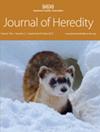Seascape genomics of the pink abalone (Haliotis corrugata): An insight into a cross-border species in the northeast Pacific coast
IF 2.5
2区 生物学
Q2 EVOLUTIONARY BIOLOGY
引用次数: 0
Abstract
Seascape genomics gives insight into the geographic and environmental factors shaping local adaptations. It improves the understanding of the potential effects of climate change, which is relevant to provide the basis for the international management of fishery resources. The pink abalone (Haliotis corrugata) is distributed from California, USA to Baja California Sur, Mexico, exposed to a latitudinal environmental gradient in the California Current System. Management of the pink abalone contrasts between Mexico and the USA; Mexico has an active fishery organized in four administrative areas, while the United States has kept the fishery in permanent closure since 1996. However, the impact of environmental factors on genetic variation along the species distribution remains unknown, and understanding this relationship is crucial for effective spatial management strategies. This study aims to investigate the neutral and adaptive genomic structure of H. corrugata. A total of 203 samples from 13 locations were processed using ddRADseq, and covering the species’ distribution. Overall, 2,231 neutral, nine potentially adaptive and three Genomic-Environmental Association (GEA) loci were detected. The neutral structure identified two groups: 1) California, USA, and 2) Baja California Peninsula, México. In addition, the adaptive structure analysis also detected two groups with genetic divergence observed at Punta Eugenia. Notably, the seawater temperature significantly correlated with the northern group (temperate) and the southern (warmer) group. This study is a valuable foundation for future research and conservation initiatives, emphasizing the importance of considering neutral and adaptive genetic factors when developing management strategies for marine species.粉红鲍鱼(Haliotis corrugata)的海景基因组学:洞察太平洋东北海岸的跨境物种
海景基因组学有助于深入了解影响当地适应性的地理和环境因素。它提高了人们对气候变化潜在影响的认识,为渔业资源的国际管理提供了依据。粉红鲍鱼(Haliotis corrugata)分布于美国加利福尼亚州到墨西哥南下加利福尼亚州,暴露在加利福尼亚洋流系统的纬度环境梯度中。墨西哥和美国对粉鲍的管理形成了鲜明对比;墨西哥在四个行政区域组织了活跃的渔业活动,而美国自 1996 年以来一直处于永久性休渔状态。然而,环境因素对物种分布沿线遗传变异的影响仍然未知,了解这种关系对有效的空间管理策略至关重要。本研究旨在调查 H. corrugata 的中性和适应性基因组结构。使用 ddRADseq 处理了来自 13 个地点的共 203 个样本,涵盖了该物种的分布。共检测到 2,231 个中性基因位点、9 个潜在适应性基因位点和 3 个基因环境关联(GEA)基因位点。中性结构确定了两个群体:1)美国加利福尼亚州;2)墨西哥下加利福尼亚半岛。此外,适应性结构分析也发现了两个在 Punta Eugenia 观测到遗传差异的群体。值得注意的是,海水温度与北部组(温带)和南部组(温暖)有显著相关性。这项研究为今后的研究和保护措施奠定了宝贵的基础,强调了在制定海洋物种管理策略时考虑中性和适应性遗传因素的重要性。
本文章由计算机程序翻译,如有差异,请以英文原文为准。
求助全文
约1分钟内获得全文
求助全文
来源期刊

Journal of Heredity
生物-遗传学
CiteScore
5.20
自引率
6.50%
发文量
63
审稿时长
6-12 weeks
期刊介绍:
Over the last 100 years, the Journal of Heredity has established and maintained a tradition of scholarly excellence in the publication of genetics research. Virtually every major figure in the field has contributed to the journal.
Established in 1903, Journal of Heredity covers organismal genetics across a wide range of disciplines and taxa. Articles include such rapidly advancing fields as conservation genetics of endangered species, population structure and phylogeography, molecular evolution and speciation, molecular genetics of disease resistance in plants and animals, genetic biodiversity and relevant computer programs.
 求助内容:
求助内容: 应助结果提醒方式:
应助结果提醒方式:


